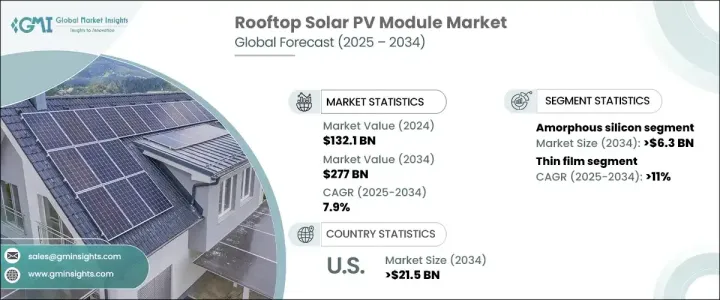PUBLISHER: Global Market Insights Inc. | PRODUCT CODE: 1685081

PUBLISHER: Global Market Insights Inc. | PRODUCT CODE: 1685081
Rooftop Solar PV Module Market Opportunity, Growth Drivers, Industry Trend Analysis, and Forecast 2025 - 2034
The Global Rooftop Solar PV Module Market reached USD 132.1 billion in 2024 and is projected to grow at a CAGR of 7.9% from 2025 to 2034. Rooftop solar photovoltaic (PV) modules, which convert sunlight into electricity using semiconductor materials like silicon, are increasingly being adopted across residential, commercial, and industrial sectors. These systems provide renewable energy for on-site consumption or can feed surplus energy back into the grid. The growing awareness of climate change and the urgent need to reduce greenhouse gas emissions are driving the adoption of renewable energy solutions. Governments worldwide are introducing incentives and subsidies to promote solar energy, further accelerating market growth.

Additionally, advancements in solar technology are improving energy conversion efficiency, making rooftop solar PV systems more cost-effective and accessible. The rising demand for sustainable energy solutions, coupled with the need for energy independence, is positioning rooftop solar PV modules as a preferred choice for consumers and businesses alike. The market is also benefiting from the increasing focus on decentralized energy systems, which enhance energy resilience during power outages and natural disasters. As the global energy landscape shifts towards cleaner alternatives, the rooftop solar PV module market is expected to witness significant growth during the forecast period.
| Market Scope | |
|---|---|
| Start Year | 2024 |
| Forecast Year | 2025-2034 |
| Start Value | $132.1 Billion |
| Forecast Value | $277 Billion |
| CAGR | 7.9% |
The market is segmented by product type, with amorphous silicon modules projected to generate USD 6.3 billion by 2034. These modules are lighter and more flexible compared to traditional crystalline silicon panels, making them suitable for a wide range of structures. Their ability to provide decentralized energy solutions is a key growth driver, as they enhance energy reliability during emergencies. The growing preference for flexible and adaptable energy systems is fueling the demand for amorphous silicon modules, particularly in regions prone to natural disasters.
In terms of technology, the thin film segment of the rooftop solar PV module market is expected to grow at an impressive 11% CAGR through 2034. Thin film technology is gaining traction due to its lightweight design, ease of installation, and flexibility, which allows it to be installed on rooftops with unconventional shapes, such as curved surfaces. Recent advancements in thin film technology, aimed at improving energy conversion efficiency and incorporating advanced materials, are further driving the growth of this segment. These innovations are making thin film modules a popular choice for both residential and commercial applications.
The U.S. rooftop solar PV module market is projected to generate USD 21.5 billion by 2034. Government initiatives, such as the Investment Tax Credit (ITC), which offers a 30% tax credit for solar system installations, are playing a significant role in driving this growth. Additionally, concerns over energy security, heightened by supply chain disruptions and natural disasters, are pushing consumers to adopt more reliable and durable energy solutions. The increasing focus on sustainability and energy independence is further boosting the demand for rooftop solar PV modules in the United States.
Table of Contents
Chapter 1 Methodology & Scope
- 1.1 Market definitions
- 1.2 Base estimates & calculations
- 1.3 Forecast calculation
- 1.4 Primary research & validation
- 1.4.1 Primary sources
- 1.4.2 Data mining sources
- 1.5 Market Definitions
Chapter 2 Executive Summary
- 2.1 Industry synopsis, 2021 – 2034
Chapter 3 Industry Insights
- 3.1 Industry ecosystem
- 3.2 Regulatory landscape
- 3.3 Industry impact forces
- 3.3.1 Growth drivers
- 3.3.2 Industry pitfalls & challenges
- 3.4 Growth potential analysis
- 3.5 Porter's analysis
- 3.5.1 Bargaining power of suppliers
- 3.5.2 Bargaining power of buyers
- 3.5.3 Threat of new entrants
- 3.5.4 Threat of substitutes
- 3.6 PESTEL analysis
Chapter 4 Competitive landscape, 2024
- 4.1 Introduction
- 4.2 Strategic dashboard
- 4.3 Innovation & sustainability landscape
Chapter 5 Market Size and Forecast, By Technology, 2021 – 2034 (USD Billion & MW)
- 5.1 Key trends
- 5.2 Thin film
- 5.3 Crystalline silicon
Chapter 6 Market Size and Forecast, By Product, 2021 – 2034 (USD Billion & MW)
- 6.1 Key trends
- 6.2 Monocrystalline
- 6.3 Polycrystalline
- 6.4 Cadmium telluride
- 6.5 Amorphous silicon
- 6.6 Copper indium gallium Di-Selenide
Chapter 7 Market Size and Forecast, By Connectivity, 2021 – 2034 (USD Billion & MW)
- 7.1 Key trends
- 7.2 On-Grid
- 7.3 Off-Grid
Chapter 8 Market Size and Forecast, By End Use, 2021 – 2034 (USD Billion & MW)
- 8.1 Key trends
- 8.2 Residential
- 8.3 Commercial & Industrial
- 8.4 Utility
Chapter 9 Market Size and Forecast, By Region, 2021 – 2034 (USD Billion & MW)
- 9.1 Key trends
- 9.2 North America
- 9.2.1 U.S.
- 9.2.2 Canada
- 9.2.3 Mexico
- 9.3 Europe
- 9.3.1 Austria
- 9.3.2 Norway
- 9.3.3 Denmark
- 9.3.4 Finland
- 9.3.5 France
- 9.3.6 Germany
- 9.3.7 UK
- 9.4 Asia Pacific
- 9.4.1 China
- 9.4.2 Australia
- 9.4.3 India
- 9.4.4 Japan
- 9.4.5 South Korea
- 9.5 Middle East
- 9.5.1 Israel
- 9.5.2 Saudi Arabia
- 9.5.3 UAE
- 9.5.4 Jordan
- 9.5.5 Oman
- 9.6 Africa
- 9.6.1 South Africa
- 9.6.2 Egypt
- 9.6.3 Algeria
- 9.6.4 Nigeria
- 9.6.5 Morocco
- 9.7 Latin America
- 9.7.1 Brazil
- 9.7.2 Chile
- 9.7.3 Argentina
- 9.7.4 Peru
Chapter 10 Company Profiles
- 10.1 Canadian Solar
- 10.2 EMMVEE SOLAR
- 10.3 Hanwha Group
- 10.4 Indosolar
- 10.5 JA Solar Technology
- 10.6 JinkoSolar
- 10.7 LONGi
- 10.8 Motech Industries
- 10.9 REC Solar Holdings
- 10.10 RENESOLA
- 10.11 Risen Energy
- 10.12 Shunfeng International Clean Energy
- 10.13 SunPower Corporation
- 10.14 Trina Solar
- 10.15 Vikram Solar
- 10.16 Yingli Solar




